Mauretanien |
|
|
|
| Übersicht – Contents: | |
Diese Seite ist Teil des Projektes
Mauretanien |
|
|
|
| Übersicht – Contents: | |
Flagge – Flag: |
|
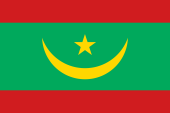 |
seit/since 2017, Nationalflagge – national flag, Seitenverhältnis – ratio = 2:3, Quelle/Source, nach/by: Wikipedia (EN)   |
historische Flaggen – historical Flags: |
|
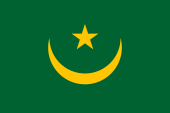 |
1959–2017, Nationalflagge – national flag, Seitenverhältnis – ratio = 2:3, Quelle/Source, nach/by: Wikipedia (EN)   |
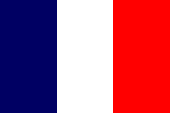 |
1903–1959, Flagge Frankreichs – flag of France, Seitenverhältnis – ratio = 2:3, Quelle/Source, nach/by: Corel Draw 4   |
| Die heutige Flagge Mauretaniens wurde am 17.08.2017 eingeführt. Sie ist grün mit zwei schmaleren roten Streifen oben und unten und zeigt in der Mitte der grünen Fläche Halbmond und Stern in Gelb. Die Spitzen des Halbmondes zeigen nach oben. Die roten Streifen wurden der Flagge beigefügt, um dem Erscheinungsbild der Flagge ein mehr afrikanisches Aussehen zu geben. Die Farbe Grün steht ferner für den Islam, Rot für Opferbereitschaft und Gelb ist Farbe des Sandes. Die Farben der Flagge scheinen heute folgendermaßen definiert zu sein, und zwar hexadezimal: Grün = #00A95C, was Pantone Hexachrome Green entsprechen würde, Rot = #D01C1F, was Pantone 1795 entsprechen würde und Gelb = #FFD700, was Pantone 109 entsprechen würde. | The
today's flag of Mauritania was introduced on 6th of August in 2017. It is
green with two more narrow red stripes up and down and shows in the center of the
green surface half-moon and star in yellow. The points of the half-moon point upward. The red stripes were added to the flag to give the appearance of the flag a more African look. The color green also stands for Islam, red for sacrifice and yellow is the color of the sand. The colours of the flag seem to be defined today as follows, in hexadecimal: green = #00A95C, which would correspond to Pantone Hexachrome Green, red = #D01C1F, which would correspond to Pantone 1795 and yellow = #FFD700, which would correspond to Pantone 109. |
| Die Farbkombination von Grün, Gelb und Rot in der heutigen Flagge sind die Panafrikanischen Farben: Etwa 1900 setzte die Panafrika - Bewegung ein, die Gemeinsamkeiten aller Menschen mit schwarzer Hautfarbe hervorheben wollte. Für die politische Einheit Afrikas steht der Farbendreiklang Grün-Gelb-Rot, den viele afrikanische Staaten nach Erlangung ihrer Unabhängigkeit in ihre Flaggen übernahmen. Das erste Land war Ghana im Jahr 1957. Als Ursprung gelten die Landesfarben von Athiopien (Abessinien, dem ältesten unabhängigen Staat Afrikas. | The
combination of the colours green, yellow and red in the today's flag are the
Pan-African colours: Perhaps in 1900 was the beginning of the
Panafrica-Movement, wich wants to emphasize the commons of all people with
black skin. For the political unity of Africa stands the colour-triad
green-yellow-red, wich used many african countries in their flags after the
independence. The first country was Ghana in 1957. As the origin apply the
colours of Ethiopia (Abessinia), the oldest independent state in Africa. |
| Die erste Flagge Mauretaniens wurde am 01.04.1959 eingeführt. Sie zeigte ein einfarbiges grünes Flaggentuch mit dem islamischen Symbolismus von Halbmond und Stern in Gelb. Die Spitzen des Halbmondes zeigten nach oben. Das Grün stand für Wohlstand und für die Hoffnung auf eine bessere Zukunft. Gelb ist nicht nur die Farbe des Sandes in der Wüste, sondern sie steht auch für die Bodenschätze des Landes. | The first
flag of Mauritania was introduced on 1st of April in 1959. It showed a
single-coloured green bunting with the islamic symbolism of half-moon and
star in yellow. The points of the half-moon pointed upward. The green stood for prosperity and for the hope for a better future. Yellow is not only the colour of the sand in the desert, but it stands for the mineral ressources of the country too. |
| Der islamische Symbolismus, in Form von Halbmond und Stern, geht auf das Osmanische Reich zurück. Der letzte Kalif (aus dem Haus der Abbasiden) war 1258 hingerichtet worden. Der Kalif, Nachfolger Mohammeds, war religiöses und weltliches Oberhaupt des "Islamischen Reichs". Um 1460 wurde das Kalifat vom Herrscher des Osmanischen Reichs wiederbelebt. Diese Funktion wurde besonders wichtig als die Türken im Jahre 1517 die Stadt Mekka eroberten, und die Funktion der obersten Hüter und Bewahrer der heiligen Stätten übernahmen. Die Kontrolle über die heiligen Stätten ging während des Ersten Weltkriegs verloren (Mekka 1916, Medina 1918). Das Kalifat wurde 1924 von der türkischen Nationalversammlung abgeschafft. | The
islamic symbolism, with thw half-moon and the star, is from Ottoman origin.
The last Calif (from the house of the Abbaside's) was executed in 1258. The
Calif – successor of Mohammed – was the religious and worldly head of the
"Islamic Empire". About 1460 the Califate was revitalized by the ruler of the Ottoman Empire. This function became more important as the Turks conquered Mecca Town in 1517, as they became the supreme protectors and preservers of the holy places. The control over the holy places got lost during the First World War (Mecca 1916, Medina 1918). In 1924 the Califate became abolished by the Turkish national congregation. |
| So haben sich Halbmond und Stern als Symbole des Islam in der ganzen Welt verbreitet. Die Verbindung dieser Symbole mit grünen Flaggen hat ihren Ursprung im osmanischen Panislamismus. Als es in Teilen des Osmanischen Reiches zu Unabhängigkeitsbewegungen kam, setzte Abdul Hamid II. diesen Bewegungen erfolgreich das einigende Band des Panislamismus entgegen. Zum Symbol des Panislamismus machte er eine grüne Flagge (Farbe des Mantels des Propheten Mohammed), und setzte das türkische Wappen darauf. Die Flagge des Islam war erschaffen. | In this
way became half-moon and star spreaded in the whole world as the Symbols of
Islam. The coupling of that symbols with green flags has its roots in the
ottoman panislamism. As there arised independence movements in some regions of the Ottoman Empire, encounts Abdul Hamid II. these movements successful with the unifying string of panislamism. To the symbol of the panislamism he made the green flag (colour of the overcoat of the Prophet Mohammed), and layed above the Turkish coat of arms. The flag of the Islam was created. |
| Quelle/Source: Flaggen Wappen Hymnen, Die Welt der Flaggen, Flaggen und Wappen der Welt, Wikipedia (EN), Volker Preuß | |
Wappen – Coat of Arms: |
|
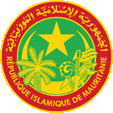 |
seit/since 2017, Siegel Mauretaniens – seal of Mauritania, Quelle/Source: Jelloud Najem, Public domain, via Wikimedia Commons |
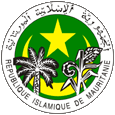 |
1960–2017, Siegel Mauretaniens – seal of Mauritania, Quelle/Source: Corel Draw 4 |
|
|
|
| Mauretanien benutzt, wie viele ehemalige französische Kolonien, als Staatswappen ein Siegel. Es wurde am 03.08.1960 eingeführt. | Mauritania uses – like many former French colonies – a seal as coat of arms. It was introduced on the 3rd of August in 1960. |
| Am 17.08.2017 wurde auch das Wappen – wie die Flagge – farblich modifiziert. Die Umrandung des Siegels wurde rot eingefärbt und strikt auf die Verwendung der Farben Rot, Gelb und Grün geachtet. | On 17th of August in 2017, the coat of arms - like the flag - was modified in colour. The border of the seal was dyed red and it was paid attention to the use of the only colours red, yellow and green. |
| Das Siegel zeigt in der Mitte im Hintergrund auf einer grünen Scheibe das Motiv der Flagge, Halbmond und Stern. Im Vordergrund eine Dattelpalme und Hirsepflanzen. Die Inschrift rings um das Siegel zeigt in arabischer und französischer Sprache den Namen des Landes. Es gibt auch einfarbige Versionen des Siegels, wobei Grün zu Schwarz wird, und Gelb zu Weiß, beziehungsweise wird der gesamte Wappenhintergrund schwarz sowie das Gelb und die die Inschrift sind weiß. Die selten verwendete Rückseite des Wappens zeigt zwischen Palmwedeln und Olivenzweigen in arabischer und französischer Sprache des Motto des Landes: "Ehre, Bruderschaft, Gerechtigkeit" | The seal shows in the middle in the background on a green disk the subject of the flag: half-moon and star. In the foreground a date-palm tree and millet plants. The inscription around the seal shows in Arabic and French language the name of the country. There are single-coloured versions of the seal too, in which green turns to black and yellow turns to white, respectively is the whole background of the coat of arms black and the yellow and the inscription are white. The rare used reverse of the coat of arms shows between palm fronds and olive twigs in Arabic and French language the motto of the country: "honor, brotherhood, justice" |
| Quelle/Source: Flaggen Wappen Hymnen, Flaggen und Wappen, Flaggen und Wappen der Welt | |
Flugzeugkokarde – aircraft roundel: |
|
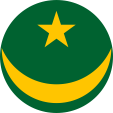 |
Flugzeugkokarde – aircraft roundel, Quelle/Source, nach/by: Wikipedia (EN) |
Landkarte – Map: |
Lage – Position: |
Landkarte des Landes – Map of the Country: |
|
|
| Zahlen und Fakten – Numbers and Facts: | |
|
|
|
|
|
|
|
|
|
|
|
|
|
|
|
|
|
|
| 1076 ·
die marokkanische Almorawiden-Dynastie erobert das Reich Ghana (heutiges
Süd-Mali und Süd-Mauretanien) und errichtet ein Großreich (heutiges Spanien,
Marokko, Westsahara, Mauretanien), Islamisierung und später auch
Arabisierung des heutigen Mauretanien, vor allem im Norden des heutigen
Mauretanien erkennen die Stämme der Schengit die Oberhoheit Marokkos bis in
die Neuzeit hinein an 1902–1910 · Eroberung des Wüstengebietes durch Französische Truppen 1903 · Errichtung des Französischen Protektorats 1920 · Angliederung an Französisch-Westafrika 1946 · Mauretanien wird Französische Überseeprovinz 28.11.1958 · Autonomie 28.11.1960 · Frankreich entlässt Mauretanien in die Unabhängigkeit → Marokko erkennt Mauretanien zunächst nicht an, stellt territoriale Forderungen und nimmt keine diplomatischen Beziehungen zu Mauretanien auf 1964 · Einparteiensystem 1966 · Rassenunruhen 1970 · Aufnahme diplomatischer Beziehungen zu Marokko 1974 · Verstaatlichung des Bergbaus (Eisenerz) 1975 · Spanien verzichtet auf seine Rechte in Westsahara, das Selbstbestimmungsrecht von Westsahara wird international anerkannt, Marokko und Mauretanien marschieren in Westsahara ein 1976 · Marokko und Mauretanien teilen Westsahara untereinander auf 1978 · Militärputsch 1979 · Mauretanien gibt seinen Teil der Westsahara zugunsten der Westsahara-Befreiungsfront "POLISARIO" auf, Marokko annektiert auch dieses Gebiet 1984 · Militärputsch 1989 · in Folge von Rassenunruhen Konflikte mit Senegal 1991 · neue Verfassung, Mehrparteiensystem 1992 · Präsidentschafts- und Parlamentswahlen 1999 · Konflikte mit Mali 2005 · Militärputsch 2006 · Wahlen 2008 · Militärputsch 2009 · Wahlen 2014 · Militärputsch |
| 1076 ·
the Moroccan Almorawide's dynasty conquers the Empire of Ghana (today's
Southern Mali and Southern Mauritania) and establishes an Empire (today's
Spain, Morocco, West Sahara, Mauritania), Islamization and later as well
Arabization of the today's Mauritania, specially in the north of the today's
Mauritania recognize the tribes of the Shengit the supremacy of Morocco
until the into the modern era 1902–1910 · conquest of the desert area by French troops 1903 · establishment of the French protectorate 1920 · annexation to French West Africa 1946 · Mauritania becomes a French overseas province 28th of November 1958 · autonomy 28th of November 1960 · France grants independence to Mauritania → Morocco recognizes Mauritania initially not, makes territorial claims and keeps no diplomatical relationships to Mauritania 1964 · single-party-system 1966 · race riots 1970 · start of diplomatical relationships to Morocco 1974 · nationalization of the mining industry (iron ore) 1975 · Spain disclaims for its rights in West Sahara, the right of sovereignity of West Sahara becomes internationally recognized, Morocco and Mauritania invade West Sahara 1976 · Morocco and Mauritania partition West Sahara among themselves 1978 · military coup 1979 · Mauritania gives up its part of West Sahara for the West Sahara Liberation Front "POLISARIO", Morocco annexes this area too 1984 · coup d'état 1989 · in result of race riots conflicts with Senegal 1991 · new constitution, multi-party-system 1992 · elections for president and parliament 1999 · conflicts with Mali 2005 · military coup 2006 · elections 2008 · military coup 2009 · elections 2014 · military coup |
| Quelle/Source: Atlas zur Geschichte, Weltgeschichte, Wikipedia (D) |
| Der Name "Mauretanien" leitet sich von den Mauren ab, der berberischen Urbevölkerung des Maghreb. Schon in der Antike wurde Name "Mauretanien" für das heutige Marokko verwendet. Heute bezeichnet man die islamische berberisch-arabische Mischbevölkerung des Maghreb als Mauren. Das Wort "Mauren" hat seinen Ursprung wahrscheinlich in dem phönizischen Wort für "dunkel" bzw. "finster". | The name
"Mauritania" has its roots in the Moors, the Berberic native population of
the Maghreb. Already in the antiquity was in use the name "Mauritania" for
the today's Morocco. Nowadays are named as Moors the Islamic Berberic-Arabic
mixed population of the Maghreb. The word "Moors" probably has its origin in
the Phoenician word for "dark". |
| Quelle/Source: Volker Preuß, Handbuch der geographischen Namen | |